Analysis of Head Displacement during a Frontal Collision at a Speed of 20 km/h—Experimental Studies
Abstract
1. Introduction
2. Research Background
3. Experimental Studies
3.1. Implementation of Experimental Research
3.2. Assumptions of Experimental Research
3.3. Objectives of Experimental Research
- The gender of the volunteers does not affect the head displacement during the low-speed crash test of 20 km/h.
- Four-point or five-point belts reduce head movement of the KPSIT C50 dummy during a low-speed frontal collision.
3.4. Neck Joint of the KPSIT C50 Dummy Used in Experimental Tests
- —component that is a function of the articular angle,
- —component that is a function of angular velocity in the joint,
- —constant selected on the basis of initial conditions,
- —initial articular moments and angles.
4. Group of Volunteers
5. Results of Experimental Studies
5.1. Analysis of the Head Displacement of Volunteers
5.2. Comparison of the Head Trajectory of Volunteers with the KPSIT C50 Dummy
5.3. Analysis of the Head Trajectory of the KPSIT C50 Dummy—Experimental Studies
6. Discussion
7. Conclusions
Funding
Institutional Review Board Statement
Informed Consent Statement
Data Availability Statement
Conflicts of Interest
Correction Statement
References
- Champahom, T.; Se, C.; Aryuyo, F.; Banyong, C.; Jomnonkwao, S.; Ratanavaraha, V. Crash Severity Analysis of Young Adult Motorcyclists: A Comparison of Urban and Rural Local Roadways. Appl. Sci. 2023, 13, 11723. [Google Scholar] [CrossRef]
- Hudecová, V.; Chriašteľ, P. The Directive Facilitating Cross-Border Exchange of Information. Arch. Automot. Eng. Arch. Motoryz. 2021, 92, 17–31. [Google Scholar] [CrossRef]
- Podosek, K.; Frej, D.; Górniak, A.; Elvira, N. 50 percentile dummy movement analysis using TEMA Automotive software. Arch. Automot. Eng. Arch. Motoryz. 2022, 97, 25–50. [Google Scholar] [CrossRef]
- Kohút, P.; Macurová, Ľ.; Rédl, M.; Ballay, M. Application of Rectification Method for Processing of Documentation from the Place of Road Accident. Arch. Automot. Eng. Arch. Motoryz. 2020, 88, 37–46. [Google Scholar] [CrossRef]
- Vrabel, J.; Rievaj, V.; Synák, F.; Babic, D. Examination of the vehicle light intensity in terms of road traffic safety: A case study. Arch. Automot. Eng. Arch. Motoryz. 2018, 81, 137–146. [Google Scholar] [CrossRef]
- Czarnecka, W. Prędkość i jej Wpływ na Wypadki na Drogach z Udziałem Zwierząt (Speed and Its Impact on Animal Accidents), Budownictwo i Architektura, t. 15, 1, Politechnika Lubelska; Wydawnictwo Politechniki Lubelskiej: Lublin, Poland, 2016; pp. 249–257. [Google Scholar]
- Wang, Q.; Wei, B.; Wei, Z.; Gao, S.; Jin, X.; Yang, P. Reconstruction of a Car–Running Pedestrian Accident Based on a Humanoid Robot Method. Sensors 2023, 23, 7882. [Google Scholar] [CrossRef]
- Naeem, A.B.; Senapati, B.; Islam Sudman, M.S.; Bashir, K.; Ahmed, A.E.M. Intelligent Road Management System for Autonomous, Non-Autonomous, and VIP Vehicles. World Electr. Veh. J. 2023, 14, 238. [Google Scholar] [CrossRef]
- Reveles-Gómez, L.C.; Luna-García, H.; Celaya-Padilla, J.M.; Barría-Huidobro, C.; Gamboa-Rosales, H.; Solís-Robles, R.; Arceo-Olague, J.G.; Galván-Tejada, J.I.; Galván-Tejada, C.E.; Rondon, D.; et al. Detection of Pedestrians in Reverse Camera Using Multimodal Convolutional Neural Networks. Sensors 2023, 23, 7559. [Google Scholar] [CrossRef]
- Li, M.; Zhang, D.; Liu, Q.; Zhang, T. Driver Injury from Vehicle Side Impacts When Automatic Emergency Braking and Active Seat Belts Are Used. Sensors 2023, 23, 5821. [Google Scholar] [CrossRef]
- Masumitsu, A.; Hitosugi, M.; Baba, M.; Nakamura, M.; Koike, K.; Ida, H.; Aoki, M. Predictive Factors of the Fatality of Motor Vehicle Passengers Involved in Far-Side Lateral Collisions: A National Crash Database Study. Healthcare 2023, 11, 1496. [Google Scholar] [CrossRef]
- Rezapour, M.; Ksaibati, K. Understanding the Complex Impacts of Seatbelt Use on Crash Outcomes. Computation 2022, 10, 58. [Google Scholar] [CrossRef]
- Vivas Pacheco, H.; Rodríguez-Mariaca, D.; Jaramillo, C.; Fandiño-Losada, A.; Gutiérrez-Martínez, M.I. Traffic Fatalities and Urban Infrastructure: A Spatial Variability Study Using Geographically Weighted Poisson Regression Applied in Cali (Colombia). Safety 2023, 9, 34. [Google Scholar] [CrossRef]
- Islam, M.K.; Reza, I.; Gazder, U.; Akter, R.; Arifuzzaman, M.; Rahman, M.M. Predicting Road Crash Severity Using Classifier Models and Crash Hotspots. Appl. Sci. 2022, 12, 11354. [Google Scholar] [CrossRef]
- Marianne, M.; Malcolm Henry, P.; Hung-Kay, C.D. Muscle activity during low-speed rear impact. Chin. J. Traumatol. 2019, 22, 80–84. [Google Scholar] [CrossRef]
- Jaśkiewicz, M.; Więckowski, D.; Poliak, M.; Frej, D. Shoulder joint design of the anthropometric dummy used for crash tests. In Proceedings of the 2020 XII International Science-Technical Conference AUTOMOTIVE SAFETY, Kielce, Poland, 21–23 October 2020; pp. 1–5. [Google Scholar] [CrossRef]
- Jaśkiewicz, M.; Frej, D.; Matej, J.; Chaba, R. Analysis of the Head of a Simulation Crash Test Dummy with Speed Motion. Energies 2021, 14, 1476. [Google Scholar] [CrossRef]
- Frej, D.; Jaśkiewicz, M. Comparison of Volunteers’ Head Displacement with Computer Simulation—Crash Test with Low Speed of 20 km/h. Sensors 2022, 22, 9720. [Google Scholar] [CrossRef]
- Gidlewski, M.; Prochowski, L. Analysis of motion of the body of a motor car hit on its side by another passenger car. In Proceedings of the Scientific Conference on Automotive Vehicles and Combustion Engines (KONMOT), Krakow, Poland, 22–23 September 2023; Volume 48, pp. 22–23, Paper No. 012039. [Google Scholar]
- Pachocki, Ł.; Bruski, D. Modeling, simulation, and validation of a TB41 crash test of the H2/W5/B concrete vehicle restraint system. Arch. Civ. Mech. Eng. 2020, 20, 467–489. [Google Scholar] [CrossRef]
- Jaśkiewicz, M.; Jurecki, R.; Witaszek, K.; Więckowski, D. Overview and analysis of dummies used for crash tests. Zesz. Nauk./Akad. Morska W Szczecinie 2013, 35, 22–31. [Google Scholar]
- Iwamoto, M.; Nakahira, Y. Development and Validation of the Total HUman Model for Safety (THUMS) Version 5 Containing Multiple 1D Muscles for Estimating Occupant Motions with Muscle Activation During Side Impacts. Stapp Car Crash J. 2015, 59, 53–90. [Google Scholar]
- Chen, H.; Tang, H.; Cheng, X.; Zhang, L.; Wang, Z. Experimental Observations of Animal Neck Injuries under Whiplash Simulations. In Proceedings of the 2012 Third International Conference on Digital Manufacturing & Automation, Gulin, China, 31 July–2 August 2012; pp. 398–401. [Google Scholar] [CrossRef]
- Moravčík, E.; Jaśkiewicz, M. Boosting car safety in the EU. In Proceedings of the 2018 XI International Science-Technical Conference Automotive Safety, Casta-Papiernicka, Častá, Slovakia, 18–20 April 2018; pp. 1–5. [Google Scholar] [CrossRef]
- Kent, R. Air Bag Loading on In-Position Hybrid III Dummy Neck. In Air Bag Development and Performance: New Perspectives from Industry, Government and Academia; SAE: Warrendale, PA, USA, 2003; pp. 601–616. [Google Scholar]
- Kent, R. Assessment of Air Bag Deployment Loads with the Small Female Hybrid III Dummy. In Air Bag Development and Performance: New Perspectives from Industry, Government and Academia; SAE: Warrendale, PA, USA, 2003; pp. 519–530. [Google Scholar]
- Lai, X.; Ma, C.; Hu, J.; Zhou, Q. Impact direction effect on serious-to-fatal injuries among drivers in near-side collisions according to impact location: Focus on thoracic injuries. Accid. Anal Prev. 2012, 48, 442–450. [Google Scholar] [CrossRef]
- Cormier, J.; Gwin, L.; Reinhart, L.; Wood, R.; Bain, C. A Comprehensive Review of Low-Speed Rear Impact Volunteer Studies and a Comparison to Real-World Outcomes. Spine 2018, 43, 1250–1258. [Google Scholar] [CrossRef] [PubMed]
- Grip, H.; Ohberg, F.; Wiklund, U.; Sterner, Y.; Karlsson, J.S.; Gerdle, B. Classification of neck movement patterns related to whiplash-associated disorders using neural networks. IEEE Trans. Inf. Technol. Biomed. 2003, 7, 412–418. [Google Scholar] [CrossRef]
- Liu, Z.; Zhang, X.; Chen, H.; Shi, Y. Optimization of Calibration Parameters for Hybrid III 5th Female Dummy Neck Calibration Based on Taguchi Method. In Proceedings of the 2010 Third International Conference on Information and Computing, Wuxi, China, 4–6 June 2010; pp. 97–100. [Google Scholar] [CrossRef]
- The Economic and Societal Impact of Motor Vehicle Crashes, 2019 (Revised). Available online: https://crashstats.nhtsa.dot.gov/Api/Public/ViewPublication/813403 (accessed on 18 August 2023).
- NHTSA: Traffic Crashes Cost America $340 Billion in 2019. Available online: https://www.codot.gov/safety/traffic-safety-pulse/2023/february/nhtsa-traffic-crashes-cost-america-340-billion-in-2019 (accessed on 18 August 2023).
- Nolet, P.S.; Nordhoff, L.; Kristman, V.L.; Croft, A.C.; Zeegers, M.P.; Freeman, M.D. Is Acceleration a Valid Proxy for Injury Risk in Minimal Damage Traffic Crashes? A Comparative Review of Volunteer, ADL and Real-World Studies. Int. J. Environ. Res. Public Health 2021, 18, 2901. [Google Scholar] [CrossRef] [PubMed]
- Kullgren, A.; Lie, A.; Tingvall, C. Comparison Between Euro NCAP Test Results and Real-World Crash Data. Traffic Inj. Prev. 2010, 11, 587–593. [Google Scholar] [CrossRef] [PubMed]
- Kim, S.; Lee, K.; Lee, D.; Lee, H. Bumper System Development to Meet New IIHS Bumper Test Using CAE and Optimization. In Proceedings of the SAE 2009 World Congress, Detroit, MI, USA, 20–23 April 2009. [Google Scholar] [CrossRef]
- Liu, W.; Cheng, X.; Shan, Y.; Li, H.; Yang, H. Improvement of bumper structure for pedestrian lower leg protection based on Euro-NCAP. In Proceedings of the 2011 International Conference on Mechatronic Science, Electric Engineering and Computer (MEC), Jilin, China, 19–22 August 2011; pp. 648–652. [Google Scholar] [CrossRef]
- Przegub barkowy manekina antropometrycznego do testów zderzeniowych (Shoulder Joint of the Anthropometric Crash Test Dummy Application). Zgłoszenie oznaczono numerem: P.433041, [WIPO ST 10/C PL433041]. Available online: https://ewyszukiwarka.pue.uprp.gov.pl/search/pwp-details/P.433041 (accessed on 15 October 2023).
- Przegub kolanowy manekina antropometrycznego do testów zderzeniowych (Knee-Joint of the Anthropometric Crash Test Dummy). Zgłoszenie oznaczono numerem: P.431522, [WIPO ST 10/C PL431522]. Available online: https://ewyszukiwarka.pue.uprp.gov.pl/search/pwp-details/P.431522, (accessed on 15 October 2023).
- Itu, C.; Toderita, A.; Melnic, L.-V.; Vlase, S. Effects of Seat Belts and Shock Absorbers on the Safety of Racing Car Drivers. Mathematics 2022, 10, 3593. [Google Scholar] [CrossRef]
- Whyte, T.; Kent, N.; Keay, L.; Coxon, K.; Brown, J. Frontal crash seat belt restraint effectiveness and comfort accessories used by older occupants. Traffic Inj. Prev. 2020, 21, 60–65. [Google Scholar] [CrossRef]
- Atlas Miar Człowieka, Dane do Projektowania i Oceny Ergonomicznej (Human Atlas of Measures, Data for Design and Ergonomic Evaluation). CIOP. Available online: https://docer.pl/doc/5se5x5 (accessed on 18 August 2023).
- TEMA Pro. Available online: https://imagesystems.se/tema-pro/ (accessed on 18 August 2023).
- Xu, T.; Sheng, X.; Zhang, T.; Liu, H.; Liang, X.; Ding, A. Development and Validation of Dummies and Human Models Used in Crash Test. Appl. Bionics Biomech. 2018, 2018, 3832850. [Google Scholar] [CrossRef]
- Davidsson, J.; Deutscher, C.; Hell, W.; Lövsund, P.; Svensson, M.Y. Human Volunteer Kinematics in Rear-End Sled Collisions. J. Crash Prev. Inj. Control 2001, 2, 319–333. [Google Scholar] [CrossRef]
- Carlsson, A.; Linder, A.; Davidsson, J.; Hell, W.; Schick, S.; Svensson, M. Dynamic Kinematic Responses of Female Volunteers in Rear Impacts and Comparison to Previous Male Volunteer Tests. Traffic Inj. Prev. 2011, 12, 347–357. [Google Scholar] [CrossRef]
- Sandoz, B.; Persohn, S.; González-García, M.; Weber, J. Société de Biomécanique Young Investigator Award 2019: Upper body behaviour of seated humans in vivo under controlled lateral accelerations. Clin. Biomech. 2023, 105, 105952. [Google Scholar] [CrossRef]
- Sibilski, K.; Małachowski, J. Sensitivity study on seat belt system key factors in terms of disabled driver behavior during frontal crash. Acta Bioeng. Biomech. 2019, 21, 169–180. [Google Scholar] [CrossRef]
- Duma, S.M.; Moorcroft, D.M.; Gabler, H.C.; Manoogian, S.; Stitzel, J.; Duma, G.G. Analysis of pregnant occupant crash exposure and the potential effectiveness of four-point seatbelts in far side crashes. Annu. Proc. Assoc. Adv. Automot. Med. 2006, 50, 187–198. [Google Scholar] [PubMed]
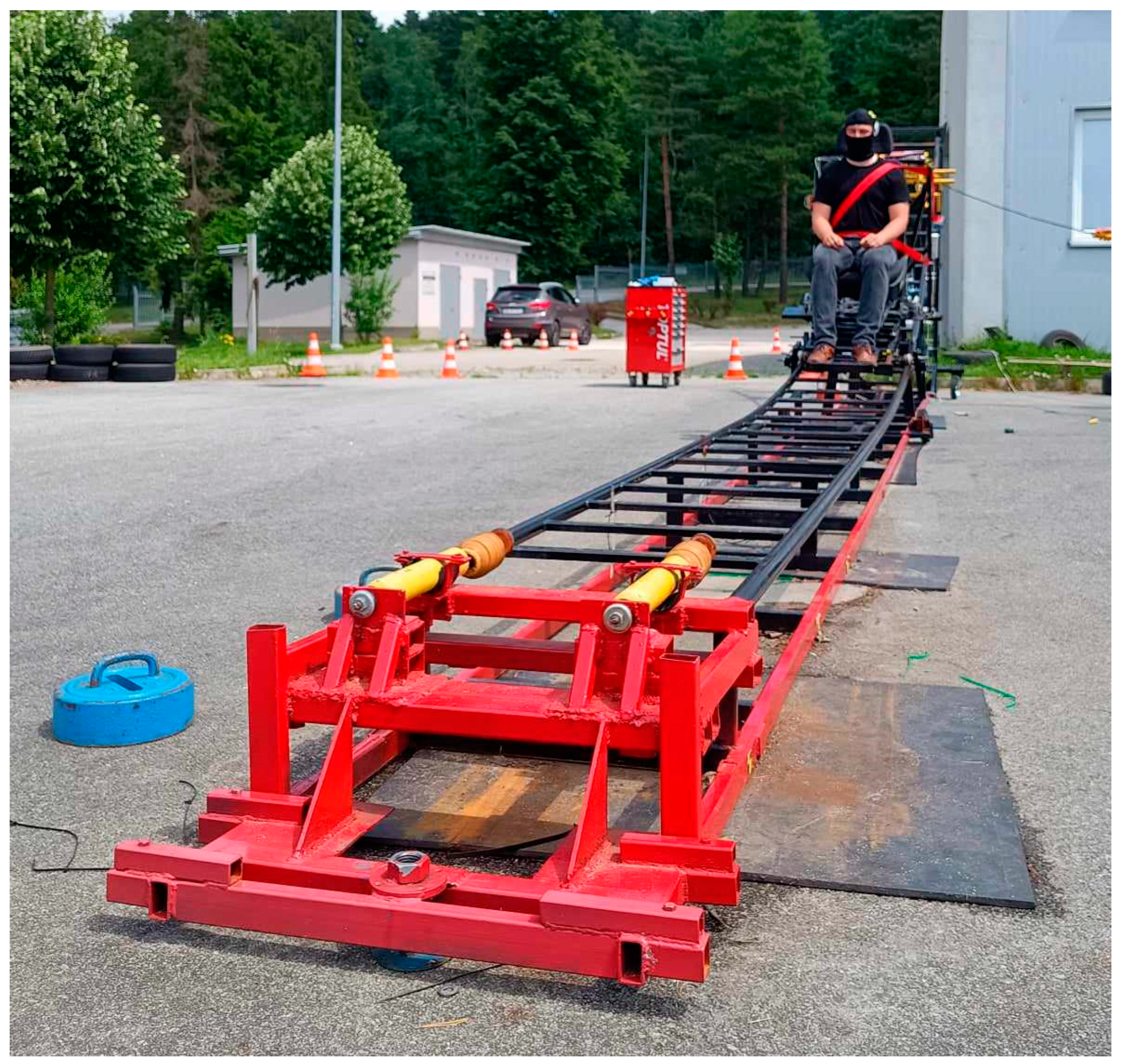

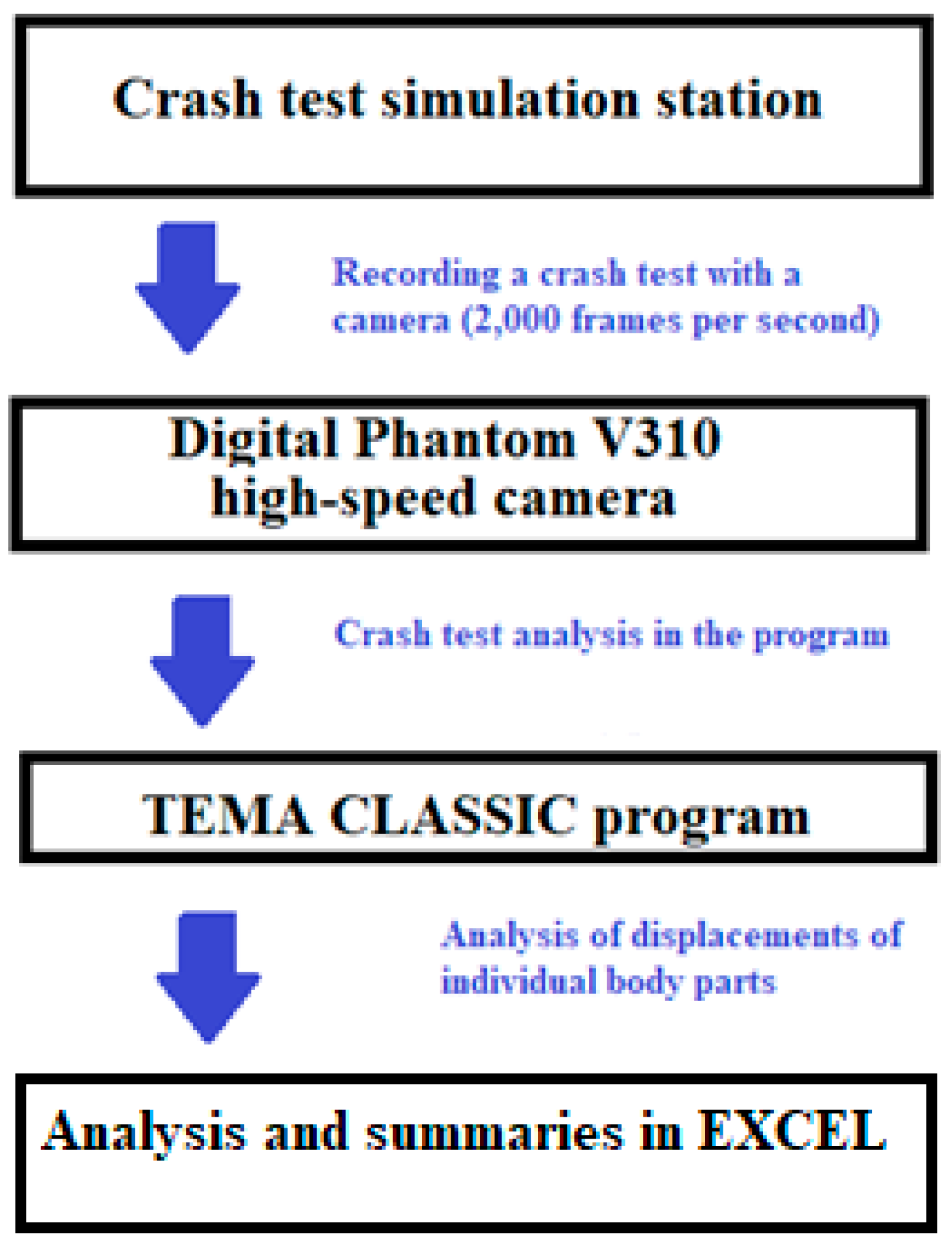
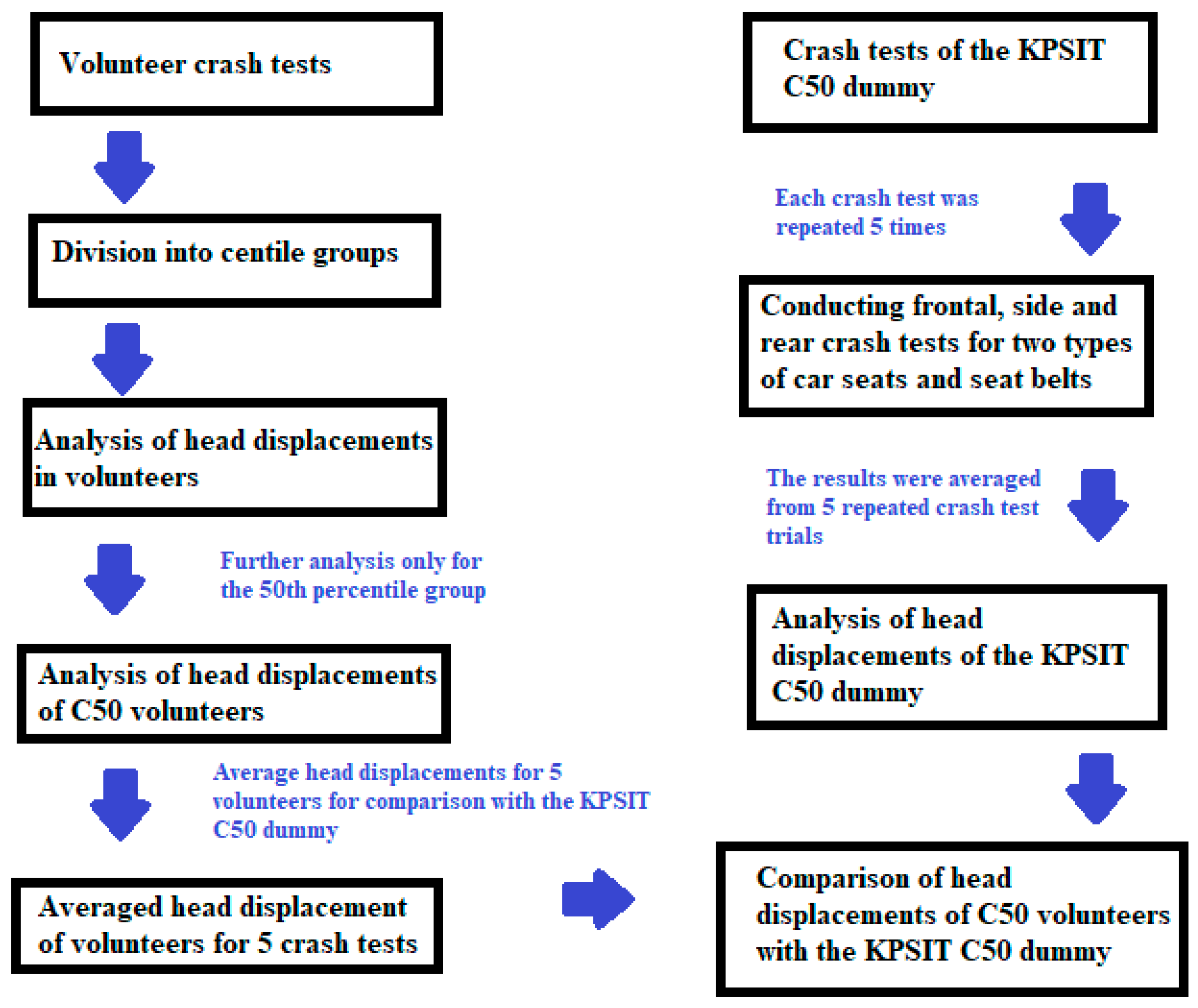
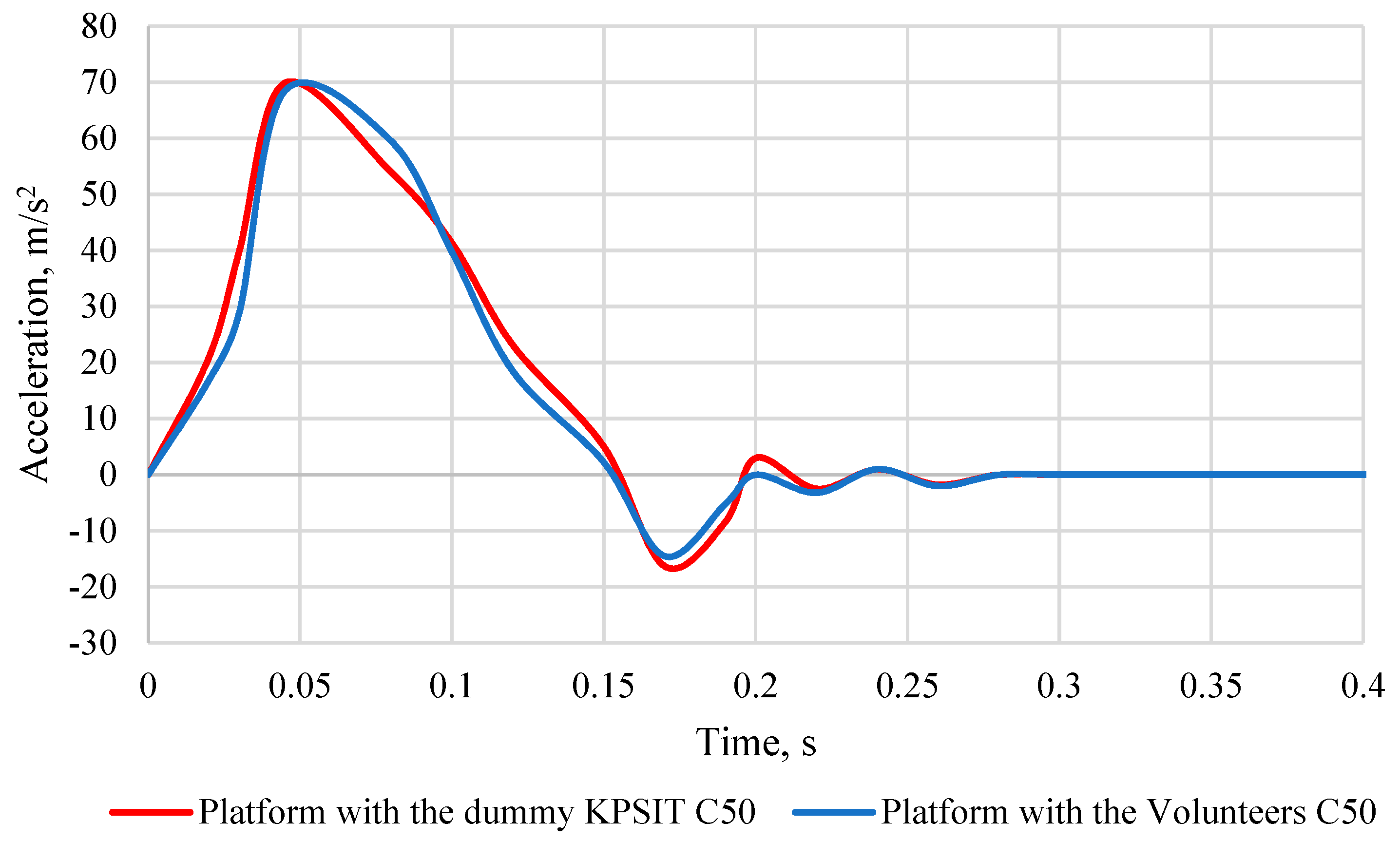



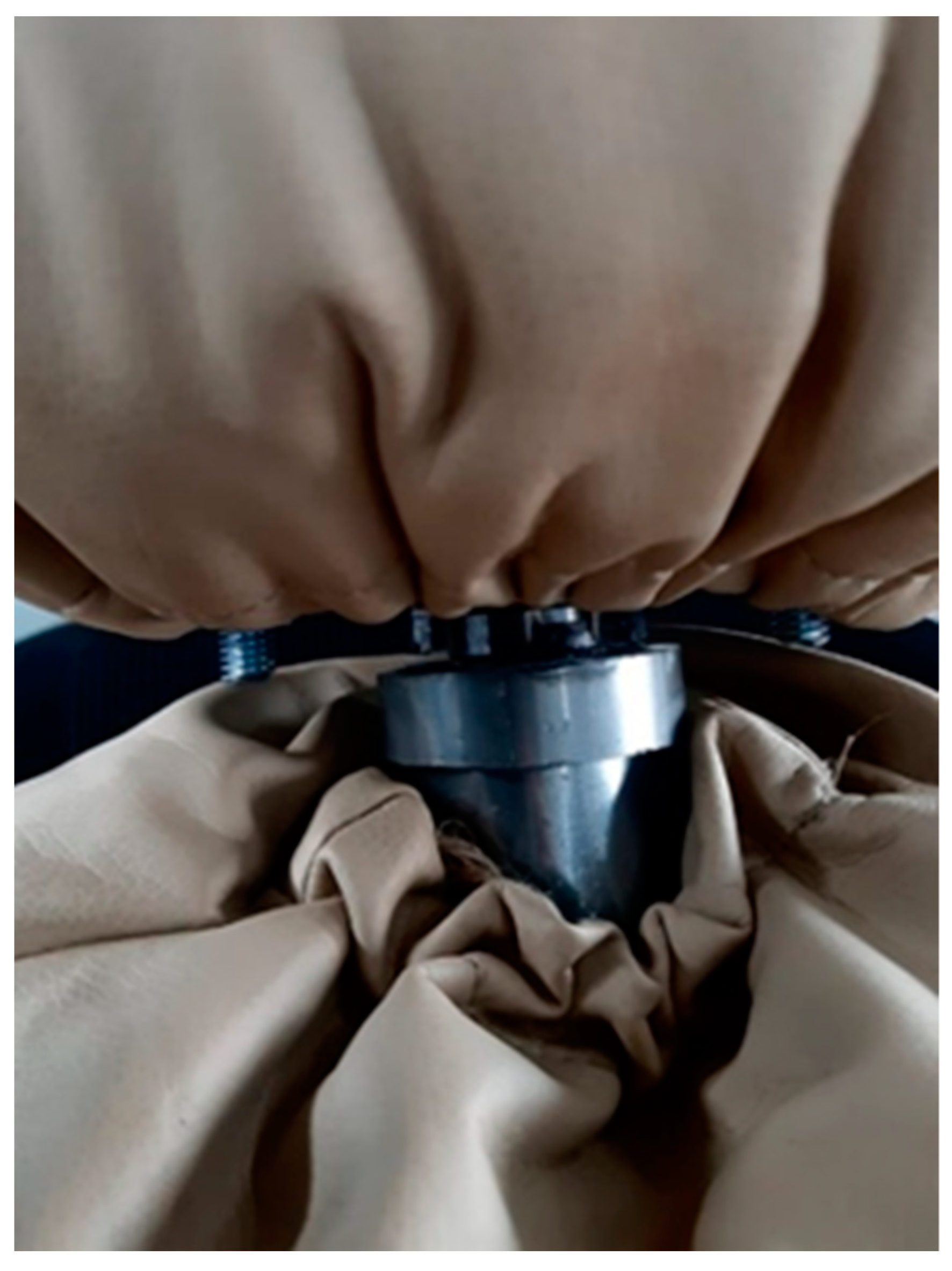
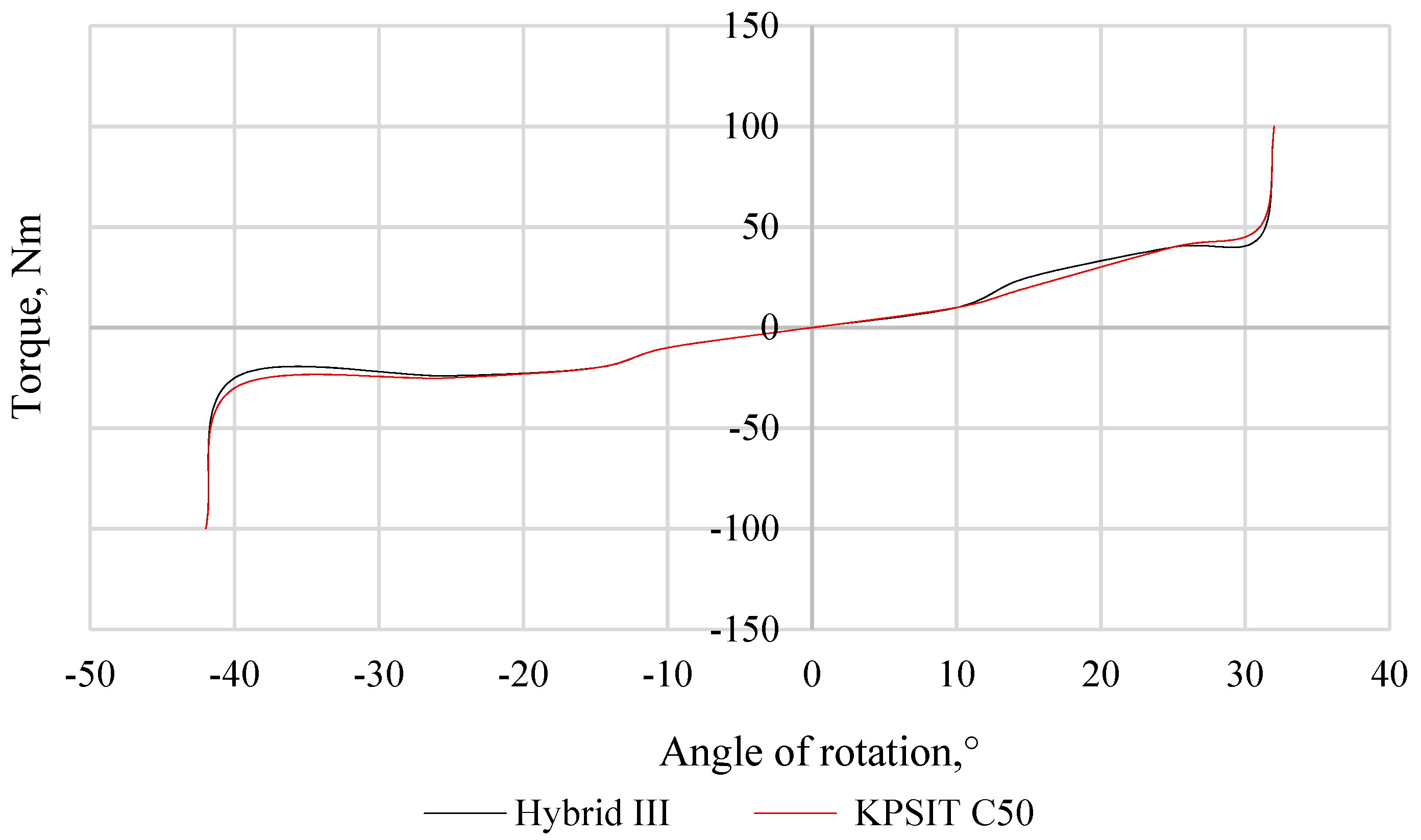
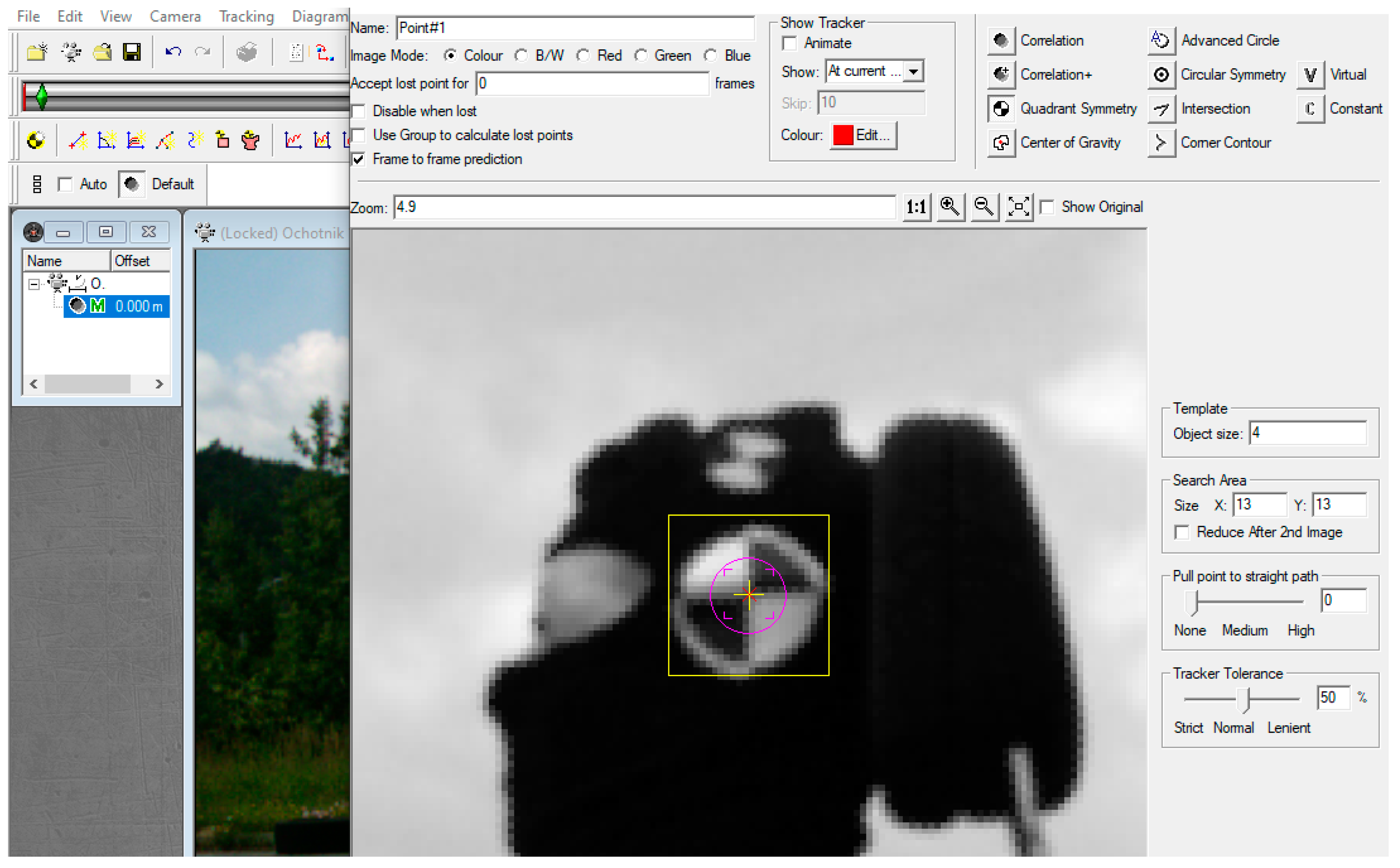


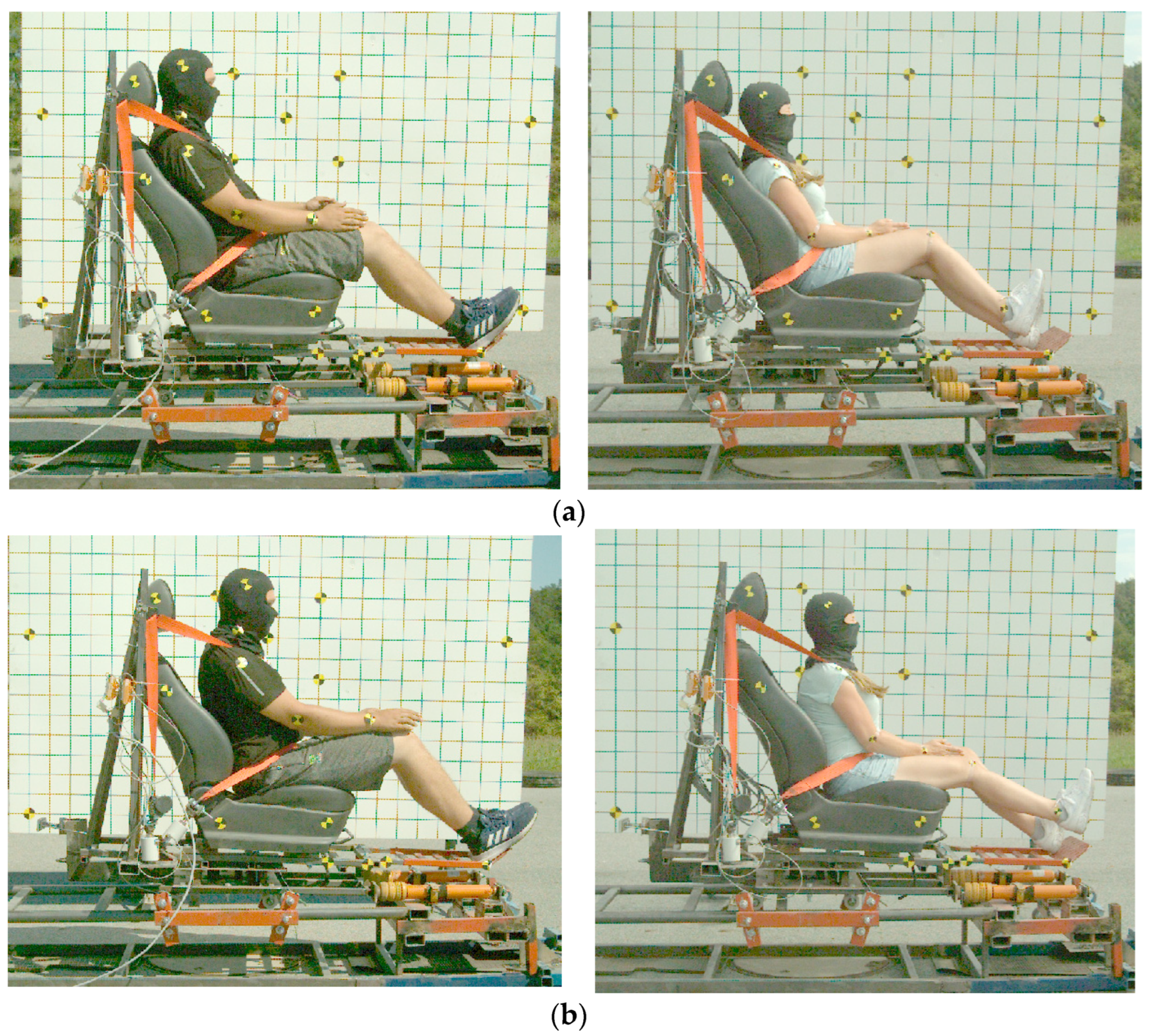
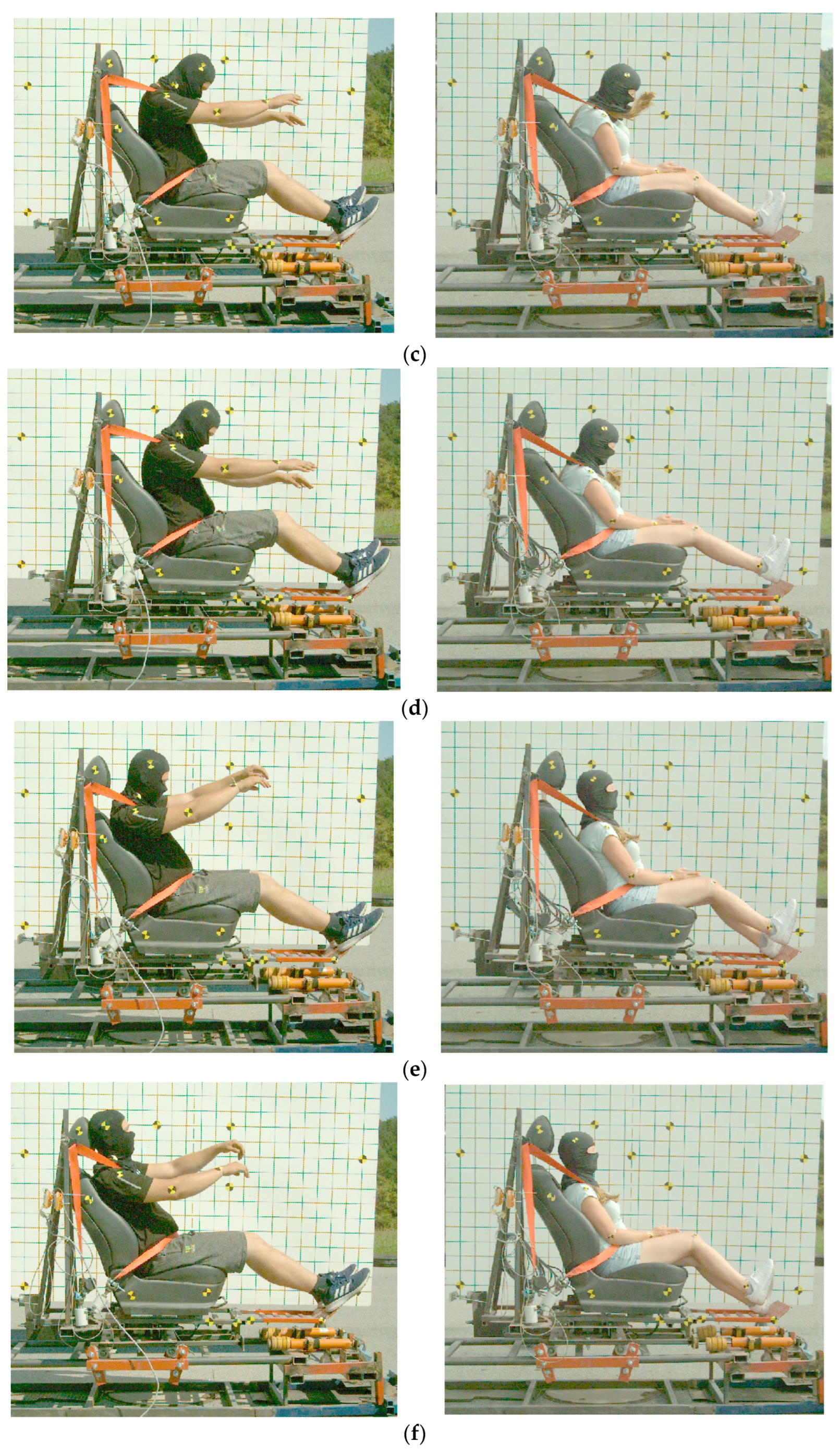
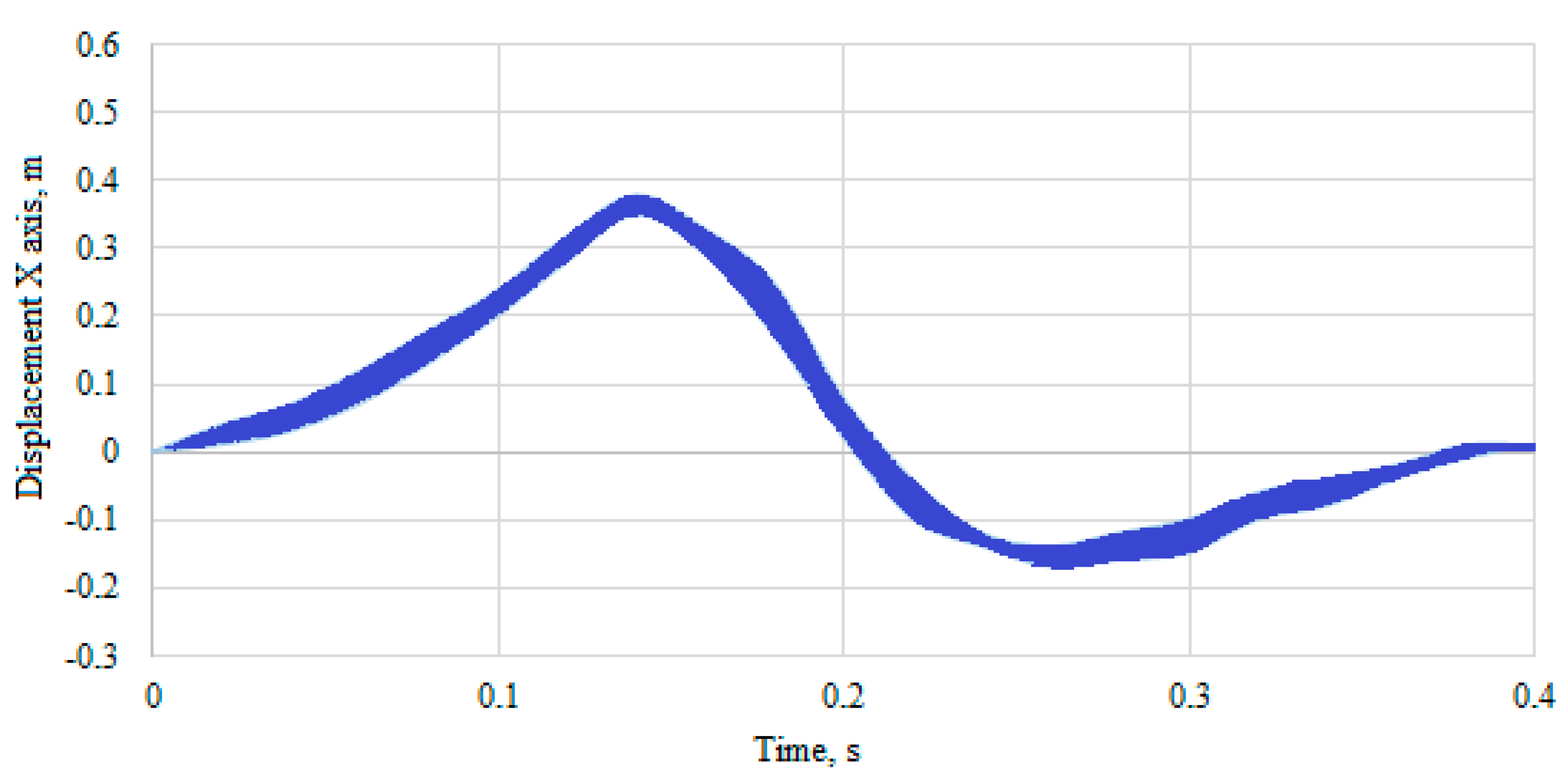



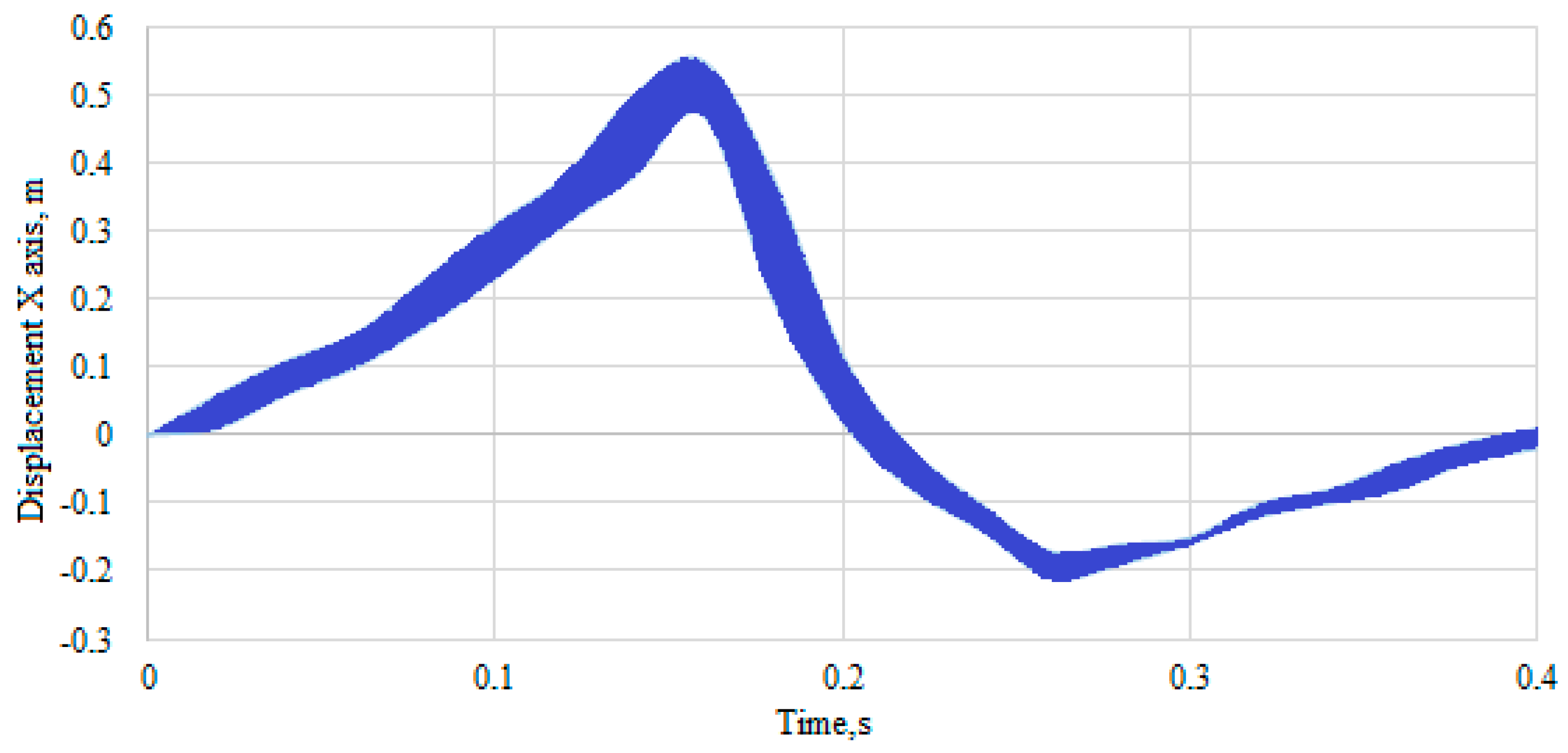
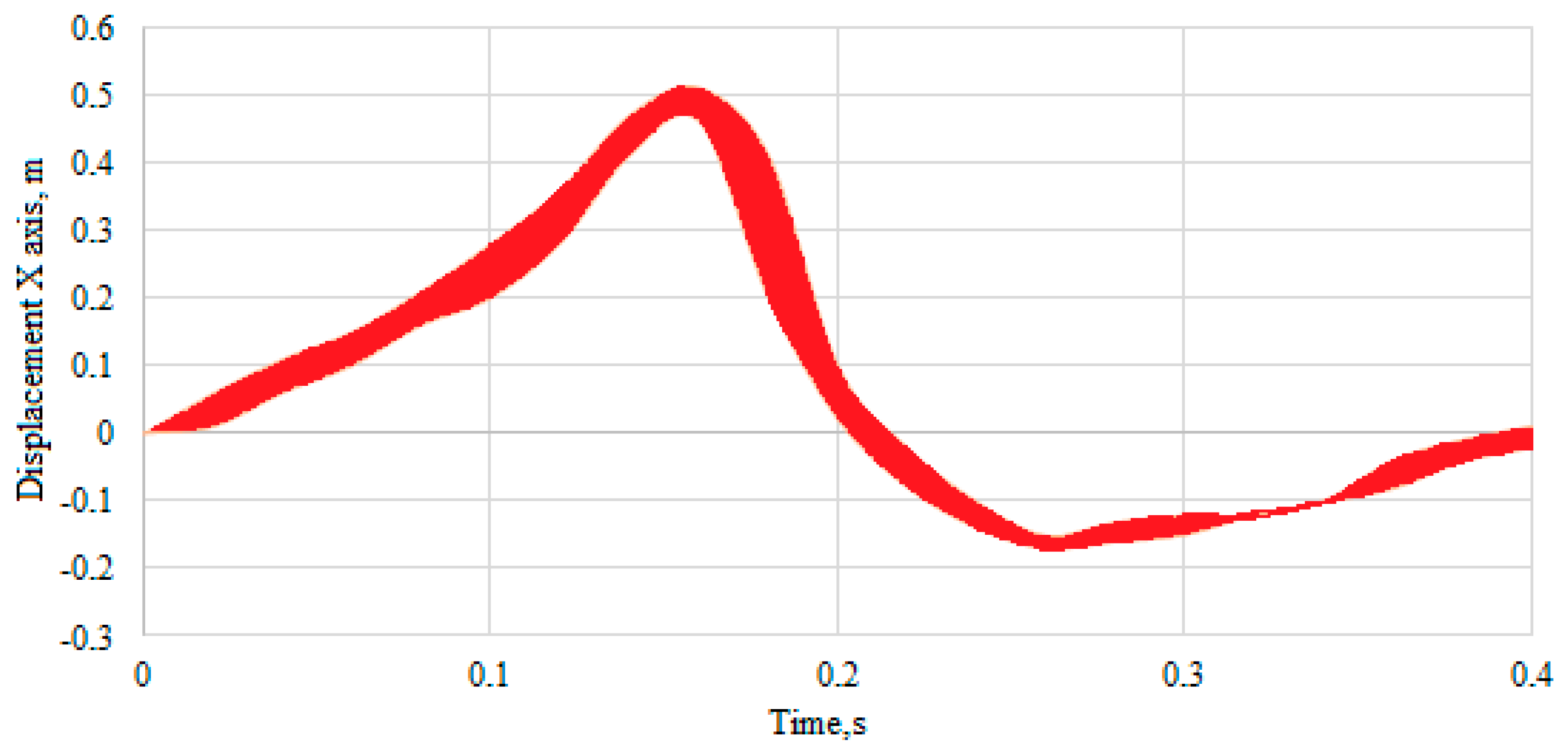

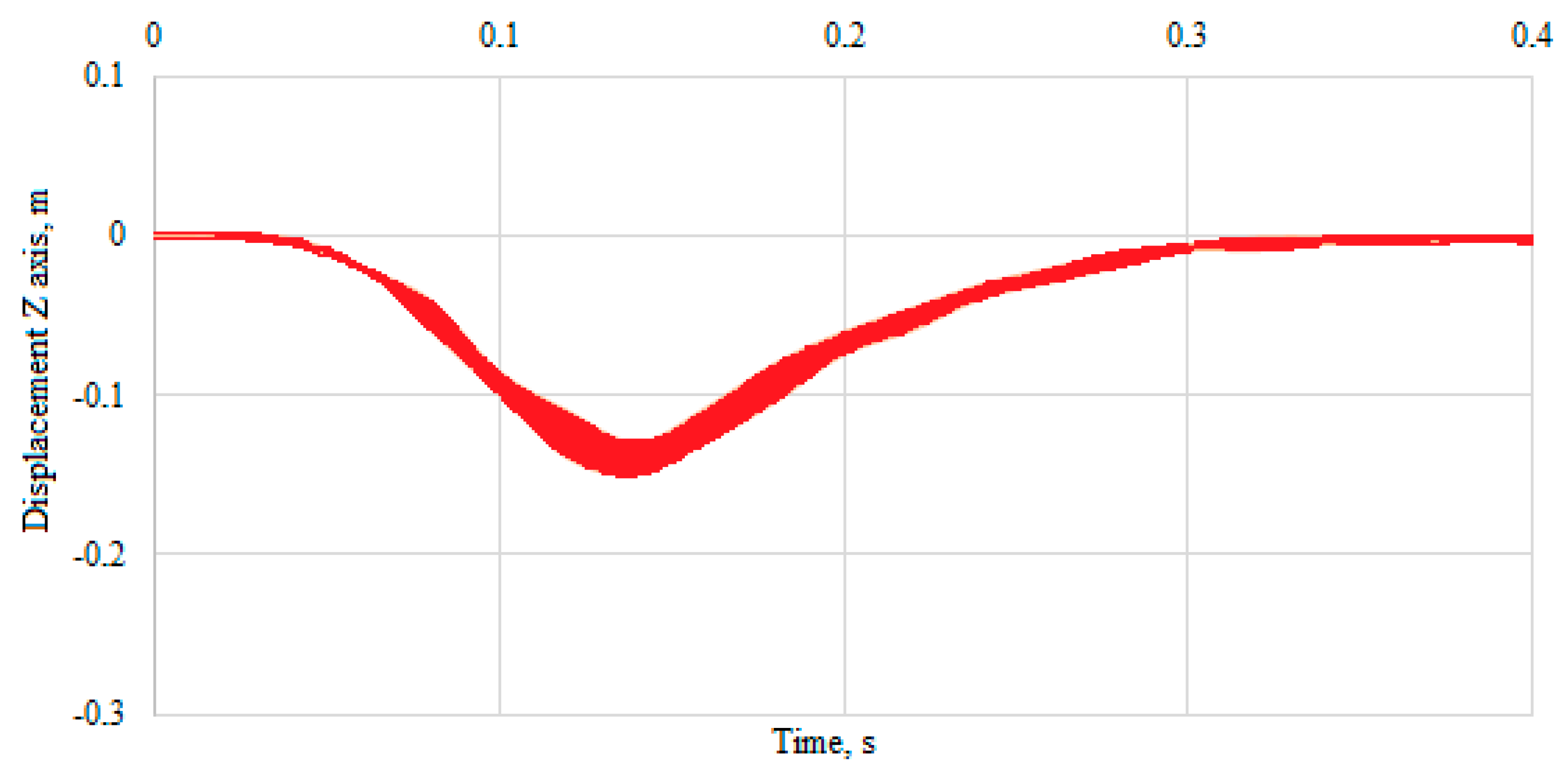
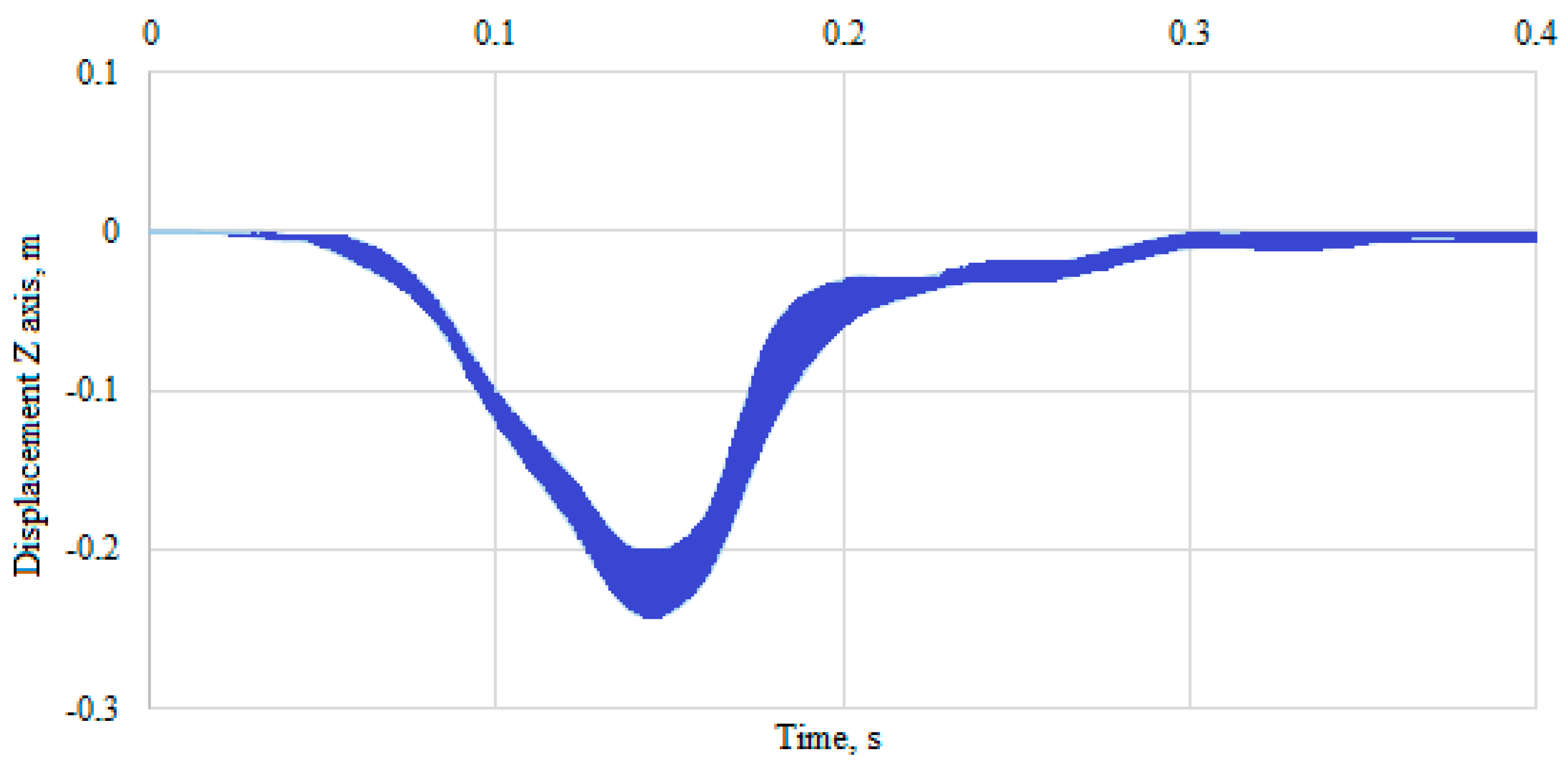

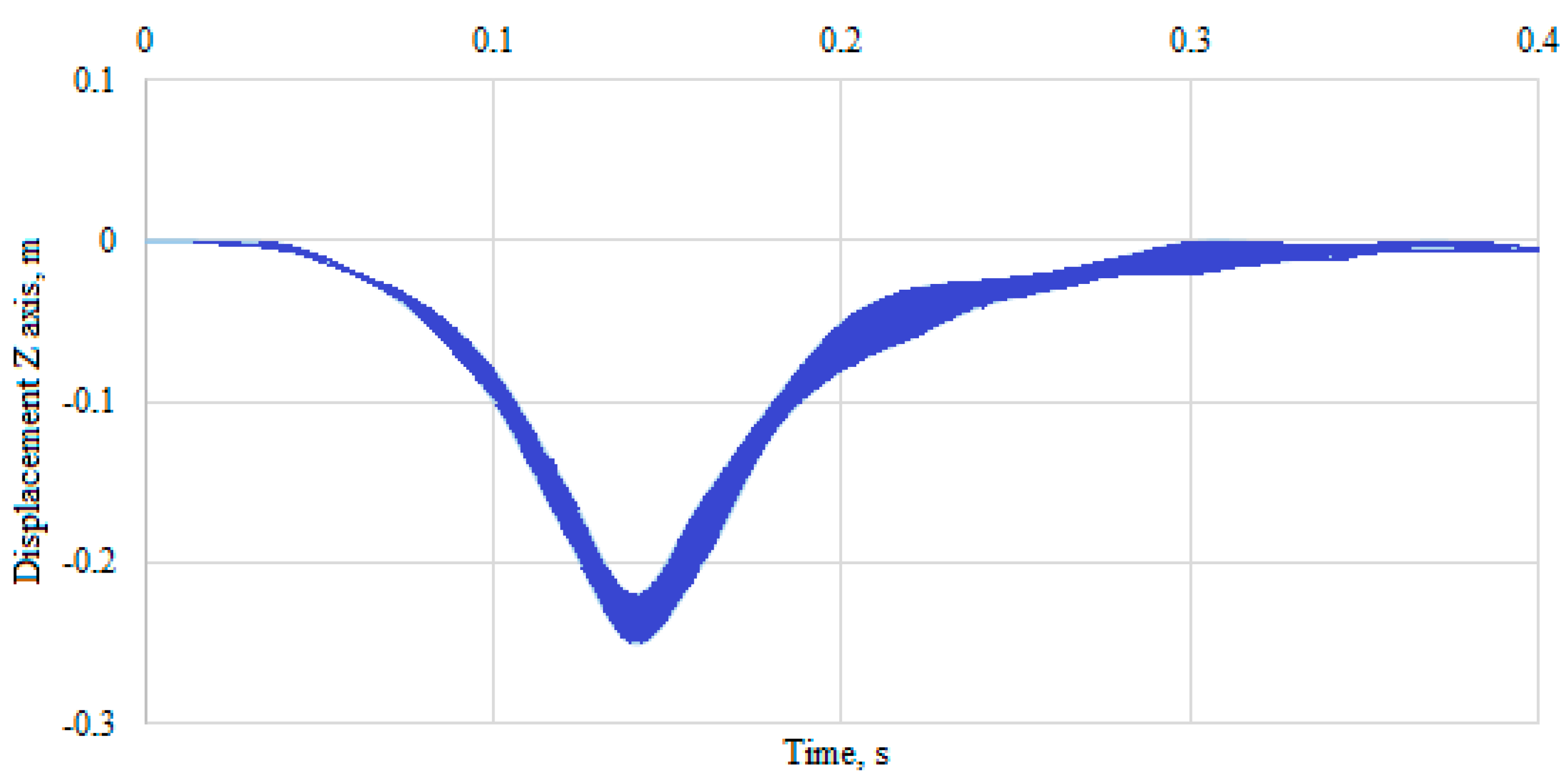

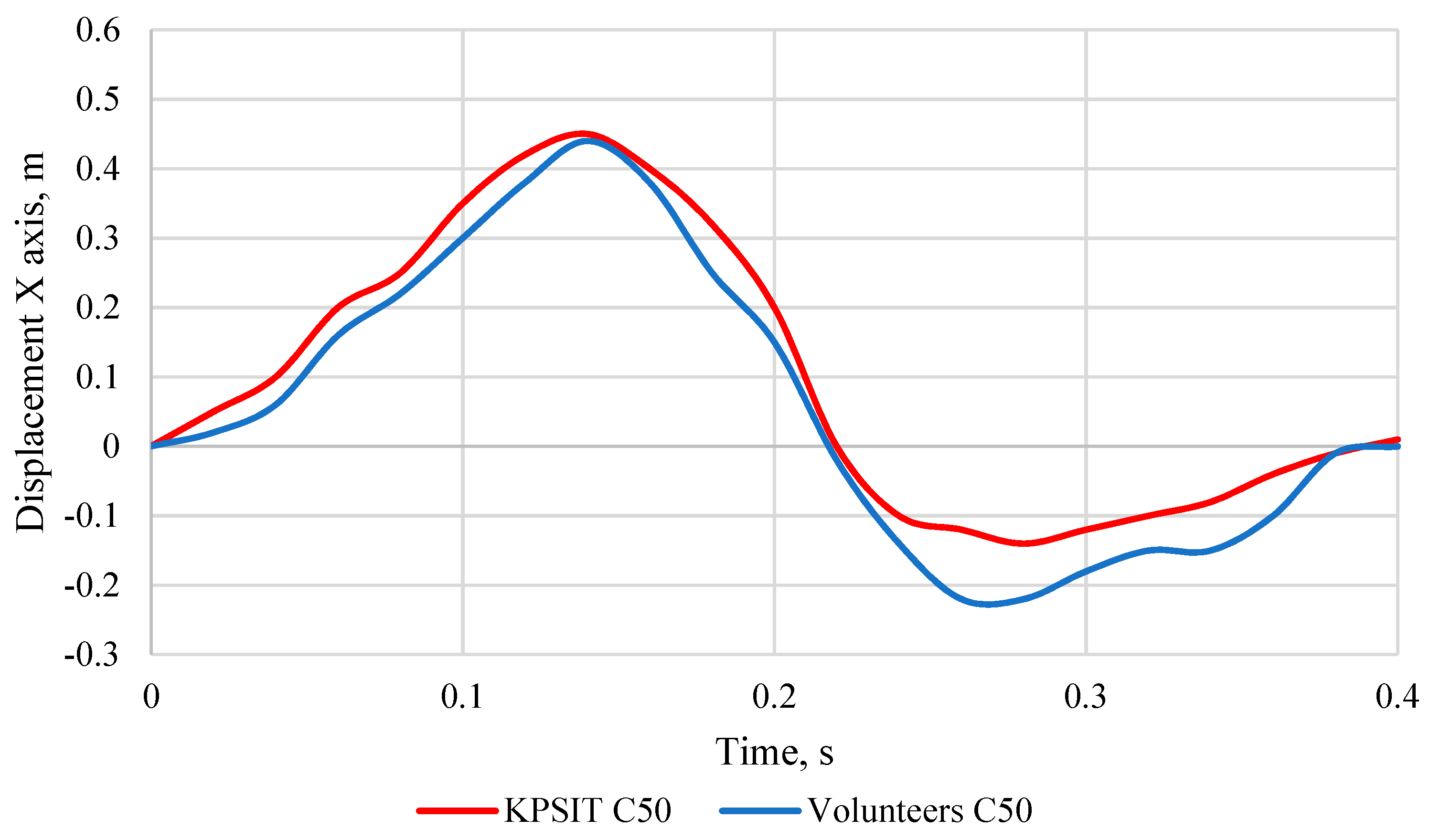
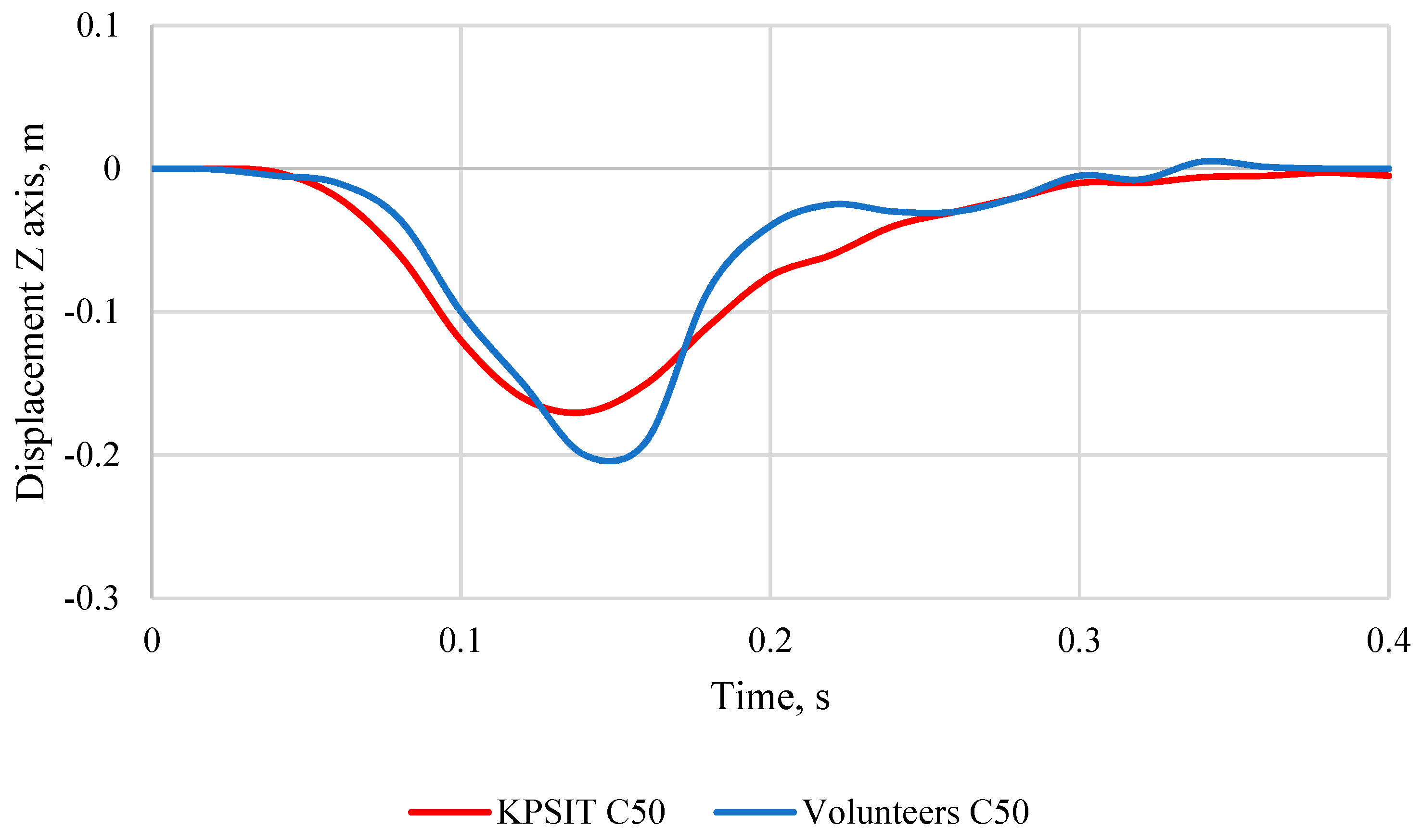
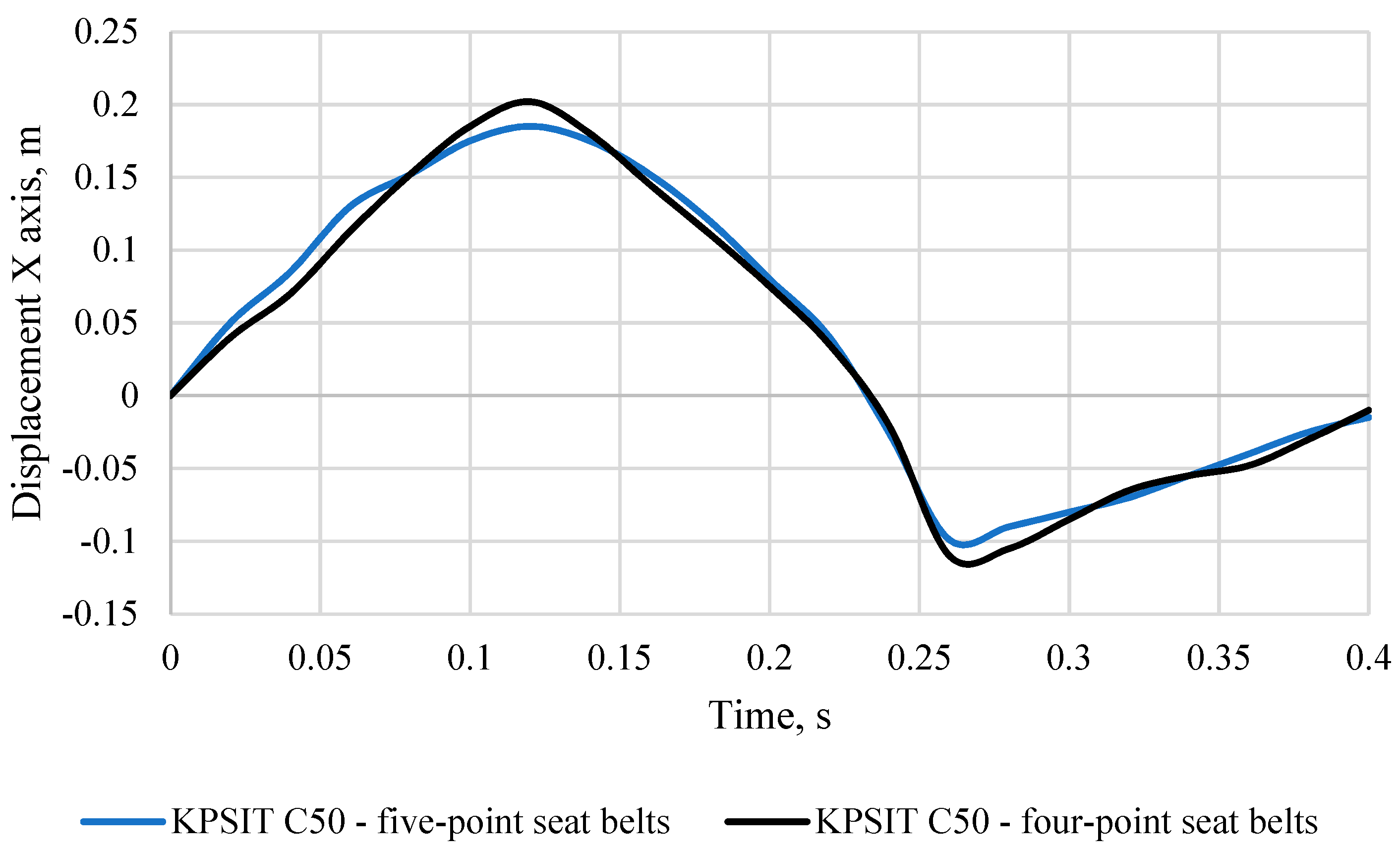

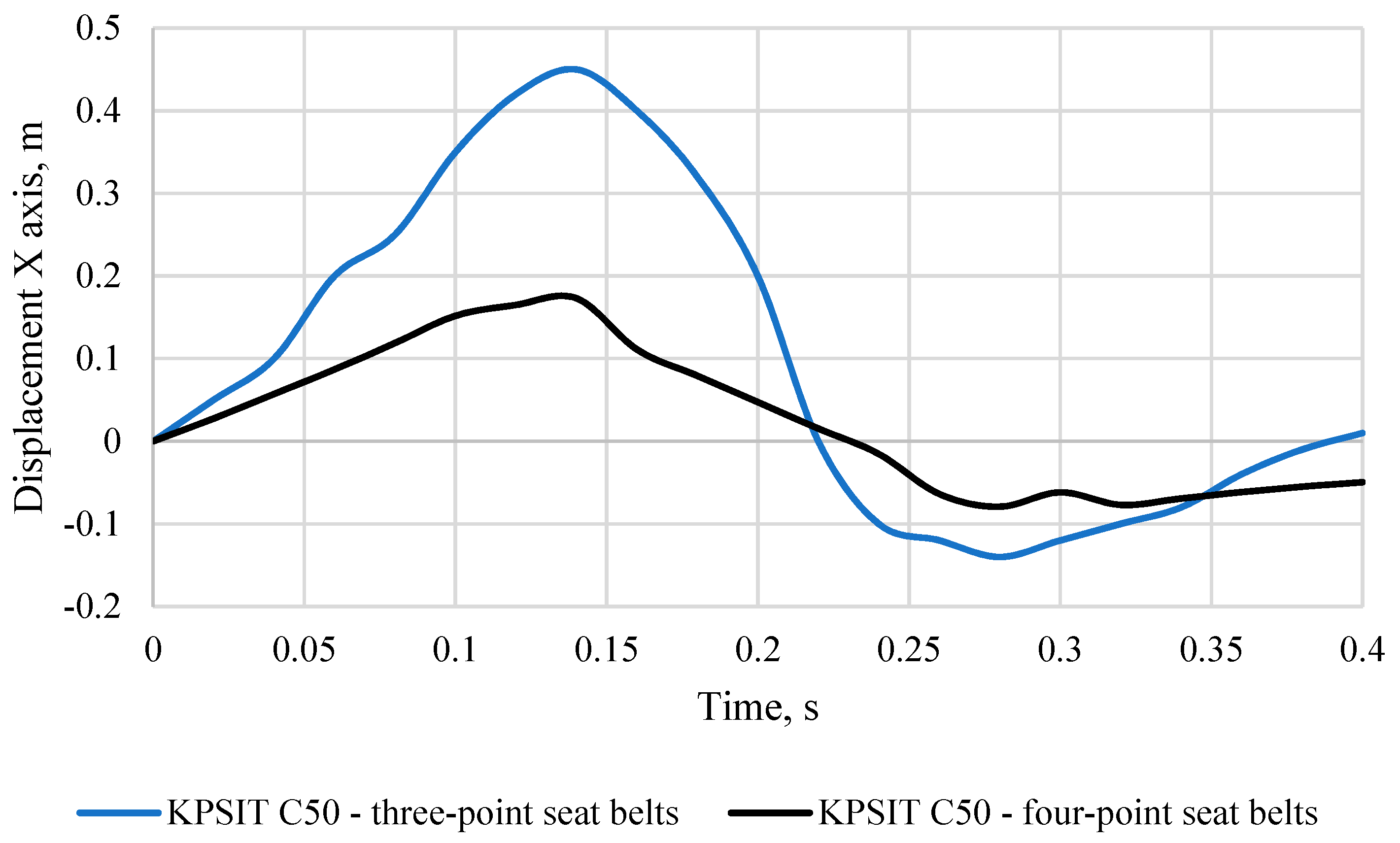

| Dimensions | Unit | Woman | Man | ||||
|---|---|---|---|---|---|---|---|
| 5th Percentile | 50th Percentile | 95th Percentile | 5th Percentile | 50th Percentile | 95th Percentile | ||
| hand length | cm | od 10.3 | od 10.4 do 11.2 | od 11.3 | od 11.0 | od 11.1 do 12.1 | od 12.2 |
| length of upper limb | cm | od 68.7 | od 68.8 do 76.9 | od 77.0 | od 74.9 | od 75.0 do 83.1 | od 83.2 |
| length of elbow axis of the handle | cm | od 32.1 | od 32.2 do 37.9 | od 38.0 | od 35.6 | od 35.7 do 40.8 | od 40.9 |
| arm length | cm | od 32.1 | od 32.2 do 35.5 | od 35.6 | od 35.8 | od 35.9 do 39.5 | od 39.6 |
| arm length (forearm) | cm | od 17.2 | od 17.3 do 18.4 | od 18.5 | od 18.9 | od 19.0 do 20.3 | od 20.4 |
| thigh length (buttock, knee) | cm | od 55.5 | od 55.6 do 60.1 | od 60.2 | od 57.8 | od 57.9 do 62.4 | od 62.5 |
| mass | kg | od 57.5 | od 57.6 do 76.5 | od 76.6 | od 69.0 | od 69.1 do 88.5 | od 88.6 |
| head circumference | cm | od 54.2 | od 54.3 do 56.8 | od 56.9 | od 55.7 | od 55.8 do 58.7 | od 58.8 |
| chest circumference | cm | od 86.7 | od 86.8 do 98.4 | od 98.5 | od 88.8 | od 88.9 do 100.2 | od 100.3 |
| shoulder width | cm | od 37.3 | od 37.4 do 40.1 | od 40.2 | od 43.4 | od 43.5 do 47.0 | od 47.1 |
| head height | cm | od 21.1 | od 21.2 do 22.9 | od 23.0 | od 22.8 | od 22.9 do 24.8 | od 24.9 |
| body height | cm | od 156.9 | od 157 do 166 | od 166.1 | od 169.5 | od 169.6 do 180.1 | od 180.2 |
| knee height | cm | od 40.4 | od 40.5 do 44.3 | od 44.4 | od 43.6 | od 43.7 do 48.3 | od 48.4 |
| crotch height (length of lower limb) | cm | od 79.5 | od 79.6 do 86.3 | od 86.4 | od 86.4 | od 86.5 do 94.1 | od 94.2 |
| medial height of the foot | cm | od 7.2 | od 7.3 do 8.1 | od 8.2 | od 8.3 | od 8.4 do 9.1 | od 9.2 |
| Dimensions | Unit | Man |
|---|---|---|
| 50th Percentile | ||
| hand length | cm | 11.5 |
| length of upper limb | cm | 81.5 |
| length of elbow axis of the handle | cm | 37.5 |
| arm length | cm | 37.5 |
| arm length (forearm) | cm | 20.0 |
| thigh length (buttock, knee) | cm | 59.5 |
| mass | kg | 82.5 |
| head circumference | cm | 57.5 |
| chest circumference | cm | 93.5 |
| shoulder width | cm | 45.0 |
| body height | cm | 179.0 |
| head height | cm | 23.5 |
| knee height | cm | 47.5 |
| crotch height (length of lower limb) | cm | 90.5 |
| medial height of the foot | cm | 8.5 |
Disclaimer/Publisher’s Note: The statements, opinions and data contained in all publications are solely those of the individual author(s) and contributor(s) and not of MDPI and/or the editor(s). MDPI and/or the editor(s) disclaim responsibility for any injury to people or property resulting from any ideas, methods, instructions or products referred to in the content. |
© 2023 by the author. Licensee MDPI, Basel, Switzerland. This article is an open access article distributed under the terms and conditions of the Creative Commons Attribution (CC BY) license (https://creativecommons.org/licenses/by/4.0/).
Share and Cite
Frej, D. Analysis of Head Displacement during a Frontal Collision at a Speed of 20 km/h—Experimental Studies. Sustainability 2023, 15, 16015. https://doi.org/10.3390/su152216015
Frej D. Analysis of Head Displacement during a Frontal Collision at a Speed of 20 km/h—Experimental Studies. Sustainability. 2023; 15(22):16015. https://doi.org/10.3390/su152216015
Chicago/Turabian StyleFrej, Damian. 2023. "Analysis of Head Displacement during a Frontal Collision at a Speed of 20 km/h—Experimental Studies" Sustainability 15, no. 22: 16015. https://doi.org/10.3390/su152216015
APA StyleFrej, D. (2023). Analysis of Head Displacement during a Frontal Collision at a Speed of 20 km/h—Experimental Studies. Sustainability, 15(22), 16015. https://doi.org/10.3390/su152216015






